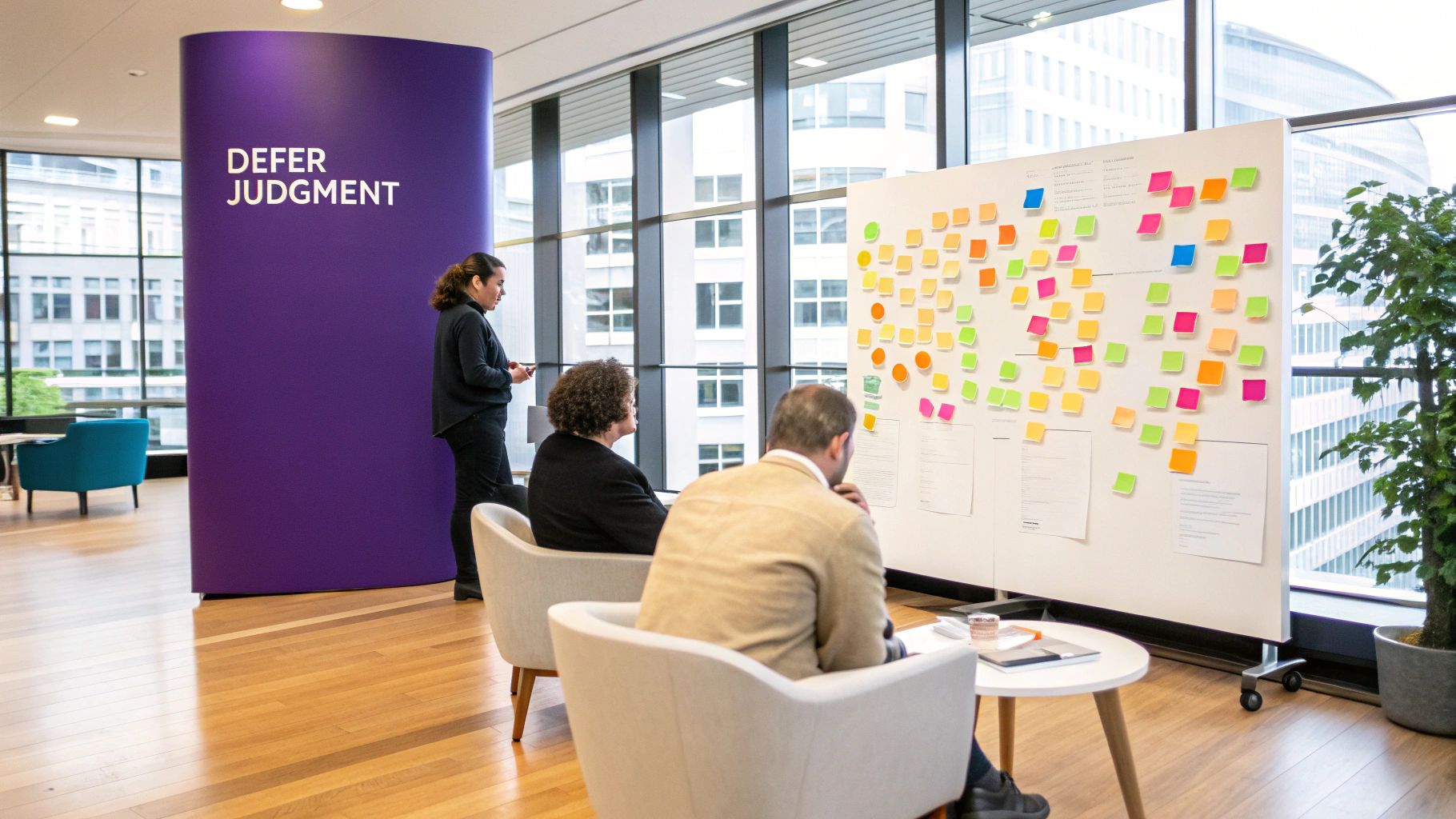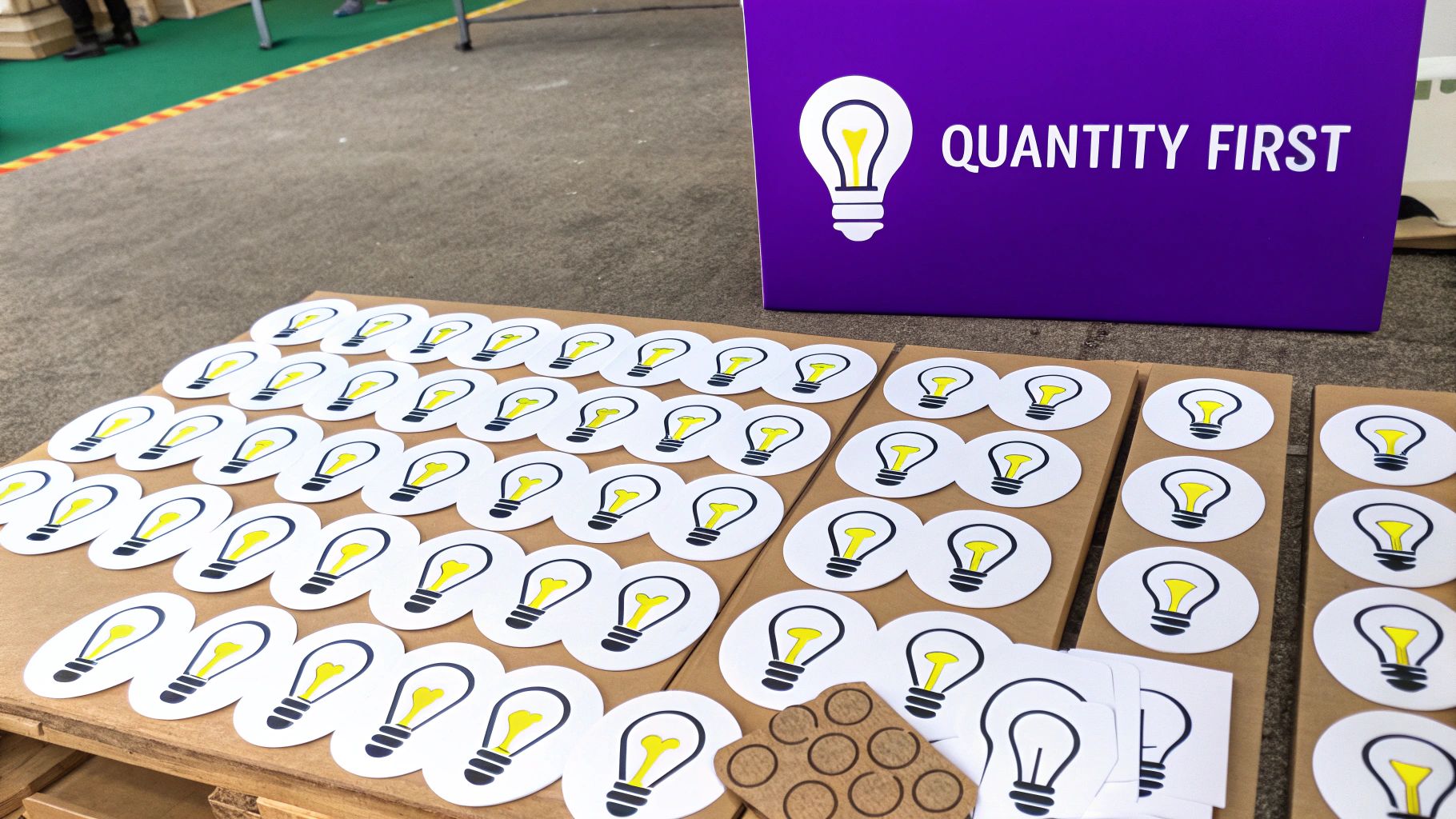In today's distributed workplaces, generating truly innovative ideas can feel more challenging than ever. How do you capture that creative spark when your team is spread across different time zones and locations? The solution lies not in more meetings, but in better ones guided by a proven framework. The fundamental rules of brainstorming, once confined to physical boardrooms, are now being reimagined for the digital age.
This guide breaks down the eight timeless principles that every remote team needs to master. Forget unstructured video calls that go nowhere; these rules provide a clear, actionable roadmap to transform chaotic conversations into powerful, idea-generating engines. Mastering these principles is the first step toward unlocking the collective genius of your team and solving your most complex challenges.
To truly unlock the genius of your remote team during brainstorming, understanding broader best practices for remote teams is fundamental. By integrating these specific brainstorming techniques with a solid foundation in remote collaboration, you create an environment where creativity can truly flourish, regardless of physical distance. Let's dive into the rules that will make your next session your most productive one yet.
1. Defer Judgment – No Criticism Allowed
The most crucial of all the rules of brainstorming is to defer judgment. This foundational principle, popularized by advertising executive Alex Osborn in the 1940s, requires all participants to suspend criticism, evaluation, and negative feedback during the idea generation phase. The goal is to create a psychologically safe environment where every idea, no matter how unconventional, can be shared without fear of immediate rejection. When team members self-censor or filter their thoughts to avoid sounding foolish, the entire creative process is stifled before it even begins.

By separating the act of idea creation from idea evaluation, teams can unlock a greater volume and diversity of thoughts. Renowned innovation firm IDEO lives by this rule, which was instrumental in developing breakthrough products like the first Apple mouse. Similarly, Google's design sprints incorporate dedicated "divergent thinking" phases where judgment is explicitly forbidden to encourage wild ideas.
How to Implement This Rule with Your Remote Team
Making this rule stick in a virtual setting requires clear facilitation and shared agreement.
- Create a 'Parking Lot' for Concerns: When a team member voices a concern or criticism (e.g., "We don't have the budget for that"), the facilitator should acknowledge it and place it in a designated "parking lot" area on the virtual whiteboard. This validates their concern while postponing the discussion until the evaluation phase.
- Use a Code Word: Establish a simple, non-confrontational word or phrase like "parking lot" or "idea-building" that anyone can use to gently remind the group to defer judgment.
- Set a Visible Timer: Clearly delineate the "no-judgment zone" by setting and displaying a timer. This reinforces that the suspension of criticism is temporary and has a defined endpoint, making it easier for analytically minded team members to adhere to the rule.
- Model the Behavior: As a facilitator or team lead, actively model non-judgmental behavior. Verbally support wild ideas and build upon them with phrases like, "Yes, and…" to show that all contributions are valuable building blocks.
2. Encourage Wild and Unusual Ideas
A core tenet of effective brainstorming is to actively encourage wild and unusual ideas. This rule pushes participants to think beyond conventional boundaries and generate concepts that may initially seem impractical, impossible, or even absurd. The purpose is not necessarily to implement these wild ideas as-is, but to use them as catalysts. They can challenge hidden assumptions, spark more feasible variations, and break the team out of incremental thinking to explore genuinely novel territory.

This approach is responsible for countless innovations. SpaceX's reusable rockets were once considered an impossible dream by industry veterans, yet this "wild idea" has fundamentally changed space travel. Similarly, Post-it Notes were born from a "failed" adhesive that was initially deemed useless. By embracing the seemingly impractical, these organizations unlocked breakthrough solutions. This principle is a cornerstone of methodologies from Alex Osborn's original brainstorming to the design thinking popularized by IDEO.
How to Implement This Rule with Your Remote Team
Fostering a space for absurdity in a virtual setting requires intentional facilitation to make people feel comfortable sharing unconventional thoughts.
- Use 'What If' Prompts: Start the session with powerful, open-ended questions that remove constraints. Ask things like, "What if money were no object?" or "If we had a magic wand, what would we do?" This framing gives permission to think big. To go deeper, learn more about asking open-ended questions to fuel creativity.
- Celebrate the Wildest Idea: Create a ritual where you briefly pause to acknowledge and celebrate the most "out there" idea. This positive reinforcement encourages more participants to share their boldest thoughts without fear.
- Ask 'How Might We…': When a wild idea is shared, instead of dismissing it, the facilitator should immediately ask, "How might we make a part of that work?" This shifts the team's mindset from evaluation to creative problem-solving and builds upon the initial spark.
- Start with an Absurdity Warm-Up: Kick off the meeting with a quick, fun exercise that encourages absurd thinking. For example, ask everyone to brainstorm terrible names for a new product for two minutes. This lowers inhibitions and gets the creative, unconventional juices flowing before tackling the main problem.
3. Go for Quantity Over Quality
One of the most effective rules of brainstorming is to prioritize a high volume of ideas over the immediate pursuit of a perfect one. This principle is built on the statistical reality that quantity ultimately breeds quality. The more concepts you generate, the greater the probability that a few of them will be truly brilliant and innovative. This approach prevents teams from getting stuck on the first few "good enough" ideas and encourages exploration beyond the obvious solutions.

This rule was a core tenet of Alex Osborn's original brainstorming method and was famously echoed by Nobel Prize winner Linus Pauling, who stated, "The best way to have a good idea is to have lots of ideas." Innovation giant IDEO lives this principle, often generating over 100 ideas in initial sessions for a single project. Similarly, Amazon's "two-pizza team" structure encourages numerous, small-scale experiments to run in parallel, maximizing the quantity of tested ideas to find what works best.
How to Implement This Rule with Your Remote Team
Driving a high volume of ideas in a virtual environment requires structure and momentum. For more tips on how to prepare your team, you can learn more about how to brainstorm effectively for your next session.
- Set a Specific Idea Quota: Announce a clear numerical target at the beginning of the session, such as "Let's aim for 75 ideas in the next 30 minutes." This gamifies the process and shifts the team's focus from perfection to production.
- Use Rapid-Fire Techniques: Employ methods like Round Robin, where each person shares one idea in turn, or silent brainwriting on a virtual whiteboard. These techniques maintain a quick pace and ensure everyone contributes.
- Keep Ideas Short and Sweet: Instruct participants to capture ideas as concise headlines, bullet points, or simple sketches. Avoid long descriptions, which slow down the creative flow and can lead to premature evaluation.
- Make the Count Visible: Use a shared document or virtual whiteboard to visibly track the number of ideas generated in real-time. Celebrate milestones (like reaching 25, 50, and 100 ideas) to keep energy and motivation high.
4. Build on Others' Ideas (Yes, And…)
One of the most powerful rules of brainstorming is to build upon the ideas of others rather than treating each contribution as a standalone concept. This collaborative principle, famously borrowed from improvisational theater's "Yes, And…" philosophy, encourages participants to accept an idea and then expand on it. This simple shift transforms brainstorming from a series of individual suggestions into a dynamic, collective process of creation, where ideas are combined, refined, and elevated by the group.

This method fosters a positive and additive momentum, preventing the common brainstorming pitfall where good ideas are lost because the group moves on too quickly. The legendary comedy troupe Second City uses "Yes, And…" to collaboratively build entire sketches from a single prompt. Similarly, the Stanford d.school teaches this principle as a core tenet of design thinking, helping teams develop more integrated and innovative solutions by connecting and evolving initial thoughts. The key is to see every idea not as a final product, but as a stepping stone.
How to Implement This Rule with Your Remote Team
Promoting this collaborative mindset in a virtual environment requires deliberate facilitation and the right digital tools. Understanding how to run a brainstorm session effectively is crucial for making this rule a success.
- Create 'Idea Chains': On a virtual whiteboard, use arrows or connecting lines to explicitly link new ideas to the ones that inspired them. A facilitator can prompt this by asking, "Great thought! Which existing idea does that build on?"
- Use the "Yes, And…" Phrase: Encourage team members to literally start their contributions with "Yes, and…" This practice forces a positive, additive mindset and makes the connection to the previous idea explicit.
- Try Idea Speed Dating: Break the main group into pairs in virtual breakout rooms for short, timed bursts (e.g., 3 minutes). The goal is for each pair to rapidly build on one another's ideas, generating a chain of related concepts before rejoining the main group.
- Visually Cluster Ideas: Use digital sticky notes that can be easily moved and grouped. As the session progresses, actively cluster related or combined ideas together, creating visual "families" of concepts that have been built collaboratively.
5. Stay Focused on the Topic
While encouraging wild and divergent thinking, one of the most practical rules of brainstorming is to stay focused on the topic. Effective brainstorming requires clear boundaries around the problem or question being addressed. This rule ensures that creative energy is channeled productively toward a specific goal rather than being scattered across interesting but irrelevant tangents. A well-defined problem statement acts as a North Star, guiding the exploration without stifling it.
This principle of focused creativity is a cornerstone of design thinking. For example, IDEO's famous shopping cart redesign project was guided by the specific question, "How might we improve the shopping cart experience in 5 days?" Similarly, Dyson's vacuum innovation came from a narrow focus on maintaining suction power. This disciplined approach prevents sessions from devolving into unfocused conversations that yield unusable results.
How to Implement This Rule with Your Remote Team
Keeping a remote team aligned requires a visible and constant reminder of the session's core purpose.
- Make the Focus Question Visible: Write the central problem statement or "How Might We" question in large, bold text at the top of your virtual whiteboard or shared document. This keeps the goal front and center for everyone.
- Use a 'Parking Lot' for Tangents: When a great but off-topic idea emerges, acknowledge its value and move it to a designated "parking lot" or "idea garage" section. This respects the contribution without derailing the session, allowing the team to revisit it later.
- Appoint a 'Focus Keeper': Designate one person (other than the main facilitator) to gently guide the conversation back to the central question if it starts to stray. They can simply ask, "How does this idea help us address our main challenge?"
- Frame the Problem Effectively: Start with a well-crafted question. Avoid questions that are too broad ("How can we improve our company?") or too narrow ("What color should the new button be?"). The right level of focus unlocks the most relevant creativity. To ensure your brainstorming sessions remain productive and on track, utilizing clear goals and focused discussions is key, so consider these additional tips for effective meetings.
6. One Conversation at a Time
To maintain focus and respect every contributor, one of the most effective rules of brainstorming is to ensure only one conversation happens at a time. This procedural guideline prevents the session from splintering into multiple, simultaneous discussions, which can drown out quieter voices and derail the group's collective momentum. By focusing the entire team's attention on a single speaker or idea, you create an inclusive environment where every thought is heard, acknowledged, and given the chance to be built upon.
This rule is a cornerstone of structured participation methods designed to give everyone an equal voice. For instance, Pixar's famous Braintrust meetings operate with strict protocols for giving and receiving feedback, ensuring one person has the floor. Similarly, Amazon's practice of starting meetings with silent reading forces singular focus before any discussion begins. These methods prevent dominant personalities from monopolizing the session and ensure the group's energy remains unified.
How to Implement This Rule with Your Remote Team
Managing the flow of conversation is especially critical in a virtual setting, where audio cues are limited and it's easy for people to talk over one another.
- Use a Digital Queue: Leverage features like the "raise hand" button in video conferencing tools (e.g., Zoom, Microsoft Teams). The facilitator can then call on people in the order they queued up, creating a clear and fair speaking order.
- Try the "Round Robin" Technique: Go around the virtual room and give each participant a set amount of time (e.g., 60 seconds) to share their ideas without interruption. This guarantees that every single person, from the most introverted to the most extroverted, has a dedicated slot to contribute.
- Implement Brainwriting First: Before opening the floor for discussion, have everyone spend 5-10 minutes silently writing their ideas on a shared digital whiteboard. This allows for parallel thought generation before moving into a sequential, one-at-a-time sharing process.
- Facilitate Actively: The facilitator's role is key. They must actively manage the conversation, gently interjecting if side-conversations start, and redirecting focus back to the main speaker with phrases like, "Great point, let's hear from Sarah next."
7. Be Visual – Sketch and Diagram Ideas
One of the most powerful and underutilized rules of brainstorming is to make ideas visible. This rule encourages participants to move beyond words and use sketches, diagrams, mind maps, and simple drawings to express their thoughts. The goal is communication, not artistic perfection. Visualizing ideas engages different parts of the brain, clarifies complex relationships instantly, and creates a shared, tangible reference point for the entire team to build upon.
This principle is fundamental to design thinking and innovation. Pixar, for example, storyboards every film with thousands of simple drawings to refine the narrative long before any animation begins. Similarly, the initial business model for Southwest Airlines was famously sketched out on a cocktail napkin, proving that a simple visual can capture a revolutionary concept. As visual thinking expert Dan Roam advocates, anyone can solve problems with pictures.
How to Implement This Rule with Your Remote Team
Visual collaboration is a cornerstone of effective remote brainstorming, and digital tools make it more accessible than ever.
- Use a Shared Digital Whiteboard: Tools like Miro, Mural, or Figma serve as infinite canvases where team members can draw, add sticky notes, and connect ideas in real-time. This creates a persistent visual record of the session.
- Start with a Drawing Warm-Up: Kick off the session with a low-stakes activity like a 60-second "visual telephone" or "draw your morning coffee" exercise. This breaks down the fear of drawing and reinforces that the goal is clarity, not artistry.
- Leverage Simple Shapes: Encourage the team to use a basic visual vocabulary: boxes for nouns, circles for people, and arrows for actions or relationships. This simple toolkit is enough to diagram almost any process or idea. A good brainstorming graphic organizer can provide a structured template for these visuals.
- Try the '6-8-5' Method: Challenge each participant to sketch 6-8 different variations of an idea in just 5 minutes on a single sheet. This rapid sketching technique, also known as Crazy Eights, forces participants to bypass their internal critic and explore multiple visual solutions quickly.
8. Set Time Constraints – Use Structured Timeboxing
One of the most effective rules of brainstorming is to harness the power of pressure by setting strict time limits. Instead of an open-ended session that can lose momentum, timeboxing creates a sense of urgency that sharpens focus and discourages overthinking. This constraint forces participants to move past their internal critic and trust their intuition, often leading to a higher quantity and quality of spontaneous ideas. Strategic timing prevents creative burnout while ensuring the session remains energetic and productive.
This principle is a cornerstone of modern innovation methodologies. Jake Knapp's Design Sprint, developed at Google Ventures, uses a rigid five-day schedule with strictly timed activities to solve complex problems at high speed. Similarly, hackathons generate incredible innovation within a 24 to 48-hour window, proving that intense, focused bursts of effort can yield breakthrough results. By creating scarcity of time, you make creativity a more valuable and immediate resource.
How to Implement This Rule with Your Remote Team
Applying time constraints in a virtual environment is crucial for keeping everyone engaged and aligned.
- Make the Timer Visible: Use a shared, on-screen countdown timer in your video conferencing tool or virtual whiteboard. A visible clock ensures everyone is aware of the remaining time, creating a shared sense of urgency and focus.
- Use the 'Crazy 8s' Technique: A popular timeboxed exercise is 'Crazy 8s', where each participant sketches eight distinct ideas in eight minutes. This rapid-fire method is excellent for breaking through creative blocks. Explore more virtual brainstorming techniques like this to keep sessions dynamic.
- Structure with the '15-30-15' Rule: Break your session into clear segments: 15 minutes for individual silent brainstorming, 30 minutes for group discussion and idea building, and 15 minutes for initial clustering or categorization of ideas.
- Schedule Short 'Speed Sprints': Instead of one long session, run multiple short, high-energy sprints of 5-10 minutes, each focused on a specific prompt. This maintains energy and prevents the afternoon slump that often plagues remote meetings.
Brainstorming Rules Comparison Matrix
| Item | Implementation Complexity 🔄 | Resource Requirements ⚡ | Expected Outcomes 📊 | Ideal Use Cases 💡 | Key Advantages ⭐ |
|---|---|---|---|---|---|
| Defer Judgment – No Criticism Allowed | Medium – Requires strong facilitation and discipline | Low – Mostly behavioral enforcement | Increased idea quantity, psychological safety | Early ideation phases to boost creativity | Encourages risk-taking, reduces self-censorship |
| Encourage Wild and Unusual Ideas | Medium – Needs cultural buy-in and mindset shift | Low to Medium – Depends on prompts and facilitation | Breakthrough innovations, expanded thinking | Exploration sessions aiming for radical ideas | Sparks novel ideas, challenges assumptions |
| Go for Quantity Over Quality | Medium – Setting and managing numerical goals | Low – Mainly time and tracking tools | Large pool of ideas, higher chance of breakthroughs | Time-limited brainstorming sessions | Prevents analysis paralysis, fosters momentum |
| Build on Others' Ideas (Yes, And…) | Medium – Needs facilitation to encourage collaboration | Low – Basic setup with note-taking tools | More refined ideas, collaborative innovation | Team-based ideation and iterative concept building | Leverages collective intelligence, builds cohesion |
| Stay Focused on the Topic | Low to Medium – Requires careful problem framing | Low – Mainly facilitation and documentation | Relevant, actionable ideas | Problem-solving sessions requiring precision | Ensures relevance, prevents wasted time |
| One Conversation at a Time | Medium – Needs strict facilitation and turn-taking | Low – May use talking sticks or digital tools | Inclusive participation, orderly idea flow | Group discussions needing structure | Ensures all voices heard, reduces chaos |
| Be Visual – Sketch and Diagram Ideas | Medium – Requires materials and participant comfort | Medium – Paper, markers, or digital tools | Clearer communication, enhanced memory retention | Visual or spatial idea generation sessions | Engages creativity, transcends language barriers |
| Set Time Constraints – Use Structured Timeboxing | Low to Medium – Involves timer setup and session planning | Low – Timer/device and discipline | Higher focus, balanced energy, prevents fatigue | Fast-paced or frequent brainstorming sessions | Creates urgency, prevents overthinking |
From Ideas to Impact: Making Your Brainstorms Matter
Mastering the rules of brainstorming is the key to unlocking a torrent of creative ideas, but the journey doesn't end when the timer goes off. The true value emerges when you translate that raw potential into tangible, actionable outcomes. These guidelines are not rigid laws but a flexible framework designed to create the optimal psychological safety and creative conditions for innovation, especially for remote and hybrid teams.
Think of these principles as the essential ingredients for a successful session. Deferring judgment and encouraging wild ideas create the space for originality. Focusing on quantity over quality ensures you explore every possible avenue before settling on a path. Building on others' thoughts with a "Yes, and…" mindset transforms individual contributions into powerful, collaborative concepts.
Turning Raw Ideas into Actionable Steps
The real magic happens after the brainstorm. The next crucial step is to thoughtfully evaluate, cluster, and prioritize the ideas you've generated. This is where the initial divergent thinking, fueled by the rules, shifts to convergent thinking, where you make strategic decisions.
Here's a simple roadmap for what comes next:
- Cluster & Theme: Group similar ideas together. Use a digital whiteboard to drag and drop related sticky notes into clusters. Give each cluster a descriptive theme, like "New User Onboarding" or "Q4 Marketing Campaigns."
- Refine & Clarify: For the most promising ideas, ask clarifying questions. What problem does this solve? Who is the target user? What would be the simplest first version (MVP) of this idea?
- Prioritize with a Framework: Don't just pick favorites. Use a simple prioritization matrix, like an Impact/Effort grid, to objectively assess which ideas offer the most value for the least amount of resources. This helps you identify the quick wins and the high-value strategic projects.
- Assign Ownership & Next Steps: An idea without an owner is just a wish. Assign a specific person to each prioritized idea and define a clear, immediate next step. This could be "Create a one-page project brief" or "Develop a low-fidelity prototype."
The Lasting Impact of Effective Brainstorming
By consistently applying these rules of brainstorming, you do more than just generate better ideas. You cultivate a culture of innovation and collaboration where every team member feels empowered to contribute. You build a repeatable process that turns abstract creativity into a reliable engine for growth and problem-solving. Start by intentionally implementing just one or two of these rules in your next team meeting and watch as the quality, quantity, and energy of your team's ideas begin to transform.
Ready to embed these rules directly into your workflow? Bulby is an AI-powered brainstorming and workshop platform designed for remote teams, guiding you through structured exercises that make every session productive. Transform your creative process from chaotic to consistently brilliant by trying Bulby today.

